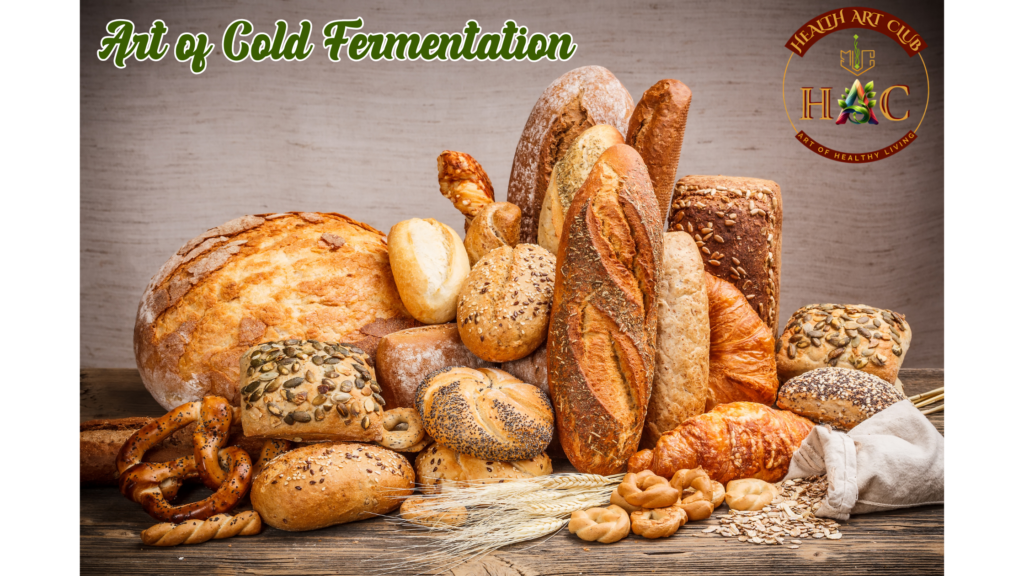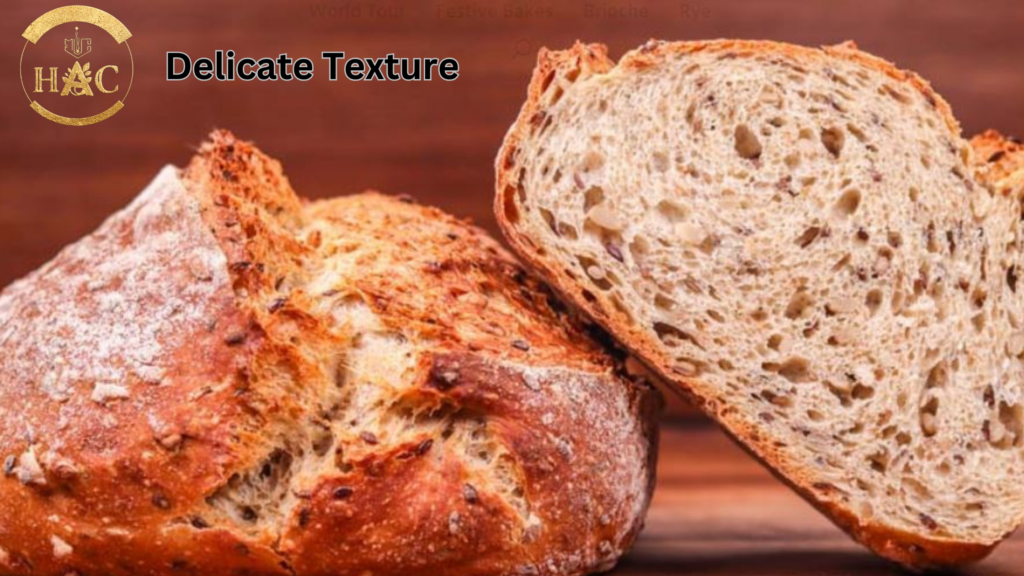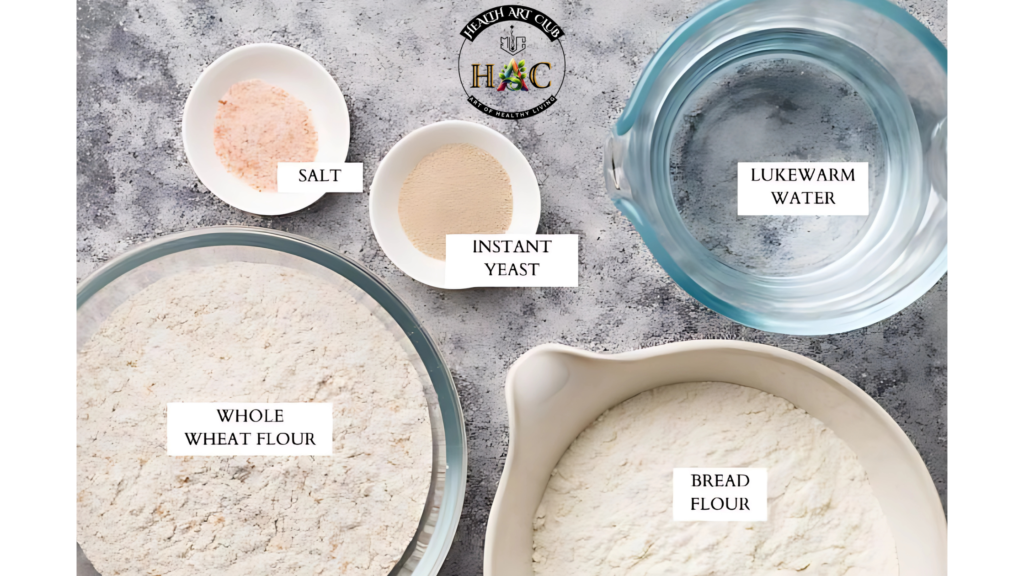Introduction:
Imagine creating bread that is not only flavorful but also healthier and easier to digest. Cold fermentation is the secret behind this tasty magic. If you’ve ever wondered why artisanal bread has such a rich aroma, eye-catching texture, and delicate taste, the answer lies in this simple yet transformative method. By the end of this guide, you’ll know everything you need to know about its health benefits and complete recipe guidelines to become a cold fermentation expert in your kitchen and master the art of making the dough rise to perfection.

What is the Science Behind Cold Fermentation?
Cold fermentation is the process of slowing down yeast activity by allowing dough to rise in the refrigerator. Typically set at 35–40°F (1–4°C), this temperature encourages the breakdown of starches and proteins, creating flavorful and airy bread. This also transforms the starch in such a way that it starts acting more or less like a fibrous diet in our digestive system. Unlike traditional proofing methods, this method ensures deeper flavor profiles and enhanced texture. The process works whether you’re crafting a rustic loaf, ciabatta, or sourdough bread (this differentiation of bread lies upon the differences in texture, flavor profile, and appearance).
Effect of Cold Fermentation on Health
Bread made using cold fermentation is a real art of healthy living. It provides various health benefits:
1. Improved Digestibility
Cold fermentation allows enzymes and bacteria to break down complex proteins like gluten naturally. This makes the bread easier on the stomach, even for those with mild digestive sensitivities.
2. Lower Glycemic Index
Cold-fermented bread is digested more slowly, resulting in a lower glycemic index. This helps regulate blood sugar levels, making it a smart choice for those with diabetes or looking to avoid energy spikes and sugar surges immediately after meals. Learn more about foods with a low glycemic index and diabetes.
3. Boosted Nutritional Value
The long fermentation process increases the bioavailability of nutrients such as zinc, magnesium, and iron, allowing your body to absorb more of the essential minerals that bread contains.
4. Improved Gut Health
Cold-fermented bread supports a healthy gut by promoting the development of beneficial bacteria. These bacteria act as natural probiotics, enhancing digestion and strengthening your immune system.
5. Natural Preservation
During fermentation, lactic acid develops, acting as a natural preservative that keeps the bread fresher for longer. This reduces reliance on artificial preservatives and extends shelf life in a natural way by preventing the growth of molds or bacteria.
6. Better for Mild Gluten Sensitivity
The slow fermentation process partially breaks down gluten, making cold-fermented bread gentler on the digestive system for people with slight sensitivities or discomfort from traditional bread, making it a healthy choice for people with celiac disease. Contact our health expert to discuss details about your disease.
Why Cold Fermented Dough Is Trending Among Bakers?
Artisan bakeries and home bakers are rapidly turning towards cold fermentation for its unbeatable results in terms of health benefits along with subtle taste. It’s not just a trend but a cornerstone of high-quality baking. Social media is buzzing with stunning visuals of golden-crusted bread made with this method. The technique accommodates even the busiest schedules and ensures perfect results every time.
Fun Fact:
Many traditional European bread recipes rely completely on cold fermentation, enriching the culinary heritage* and elevating simple ingredients like flour, yeast, and water.
*Culinary Heritage: the history and traditions of food preparation and consumption in a specific culture or region. It includes the techniques, ingredients, and stories that define a culture’s food

Benefits of Cold Fermentation
Enhanced Flavor Profile
Cold fermentation gives bread a distinct taste by allowing the dough to ferment slowly. The end product is a bread loaf bursting with delightful flavors that are truly unmatched. Thanks to the slow fermentation process, it develops a tangy zest, a mild nutty flavor, and a beautifully complex taste that quick-rise methods simply can’t replicate. Every bite tells a story of patience and care, rewarding you with a rich depth of flavor that makes the wait well worth it.
Improved Digestibility
The extended fermentation process allows enzymes to break down gluten and other proteins, making bread easier to digest. Even those with mild gluten sensitivities often find cold-fermented bread gentler on their systems.
Better Shelf Life
The development of lactic acid during fermentation is a key principle behind its prolonged and better shelf life while maintaining its freshness without any need for chemicals or preservatives.
Debunking Myths: Myth vs. Facts
- Myth 1: Cold fermentation is only for professional bakers.
- Fact: Anyone can do it! With simple tools like a digital scale and a baking oven, you can start it today.
- Myth 2: It’s too time-consuming.
- Fact: While fermentation takes longer, your active prep time is minimal.
- Myth 3: It’s only for sourdough recipes.
- Fact: This technique works with all types of bread, from classic yeasted dough to specialty loaves like ciabatta or baguettes.

Step-by-Step Procedure for Cold Fermentation
Ingredients:
- Flour (500g)
- Water (350ml)
- Salt (10g)
- Yeast (2g) or sourdough starter (50g)
Steps:
- Mix the Dough: Combine the flour, water, salt, and yeast, kneading until smooth.
- First Rise: Let the dough sit at room temperature for an hour.
- Refrigerate: Cover with plastic wrap and refrigerate for 12–48 hours.
- Shape and Proof: Shape the dough and allow it to proof for 1–2 hours at room temperature.
- Bake: Preheat the oven to 450°F (230°C) and bake your loaf until golden brown.
Common Challenges and How to Overcome Them
- Dough Feels Too Sticky: Lightly dust with flour before handling.
- Dough Didn’t Rise Enough: Ensure the yeast is fresh and the water is at the correct temperature.
- Uneven Baking: Use a baking stone for better heat distribution.
Popular Cold-Fermented Recipes
- Rustic Loaf: Ideal for beginners and delicious as is or toasted.
- Ciabatta: Perfect for sandwiches, thanks to its open crumb structure.
- Baguettes: These crispy, golden loaves are worth the extra effort.
Essential Tools for Cold Fermentation Success
- Digital Scale: For precise ingredient measurements.
- Proofing Basket: Maintains the dough’s shape during fermentation.
- Dutch Oven: Creates steam, which is crucial for a professional crust.
Pro Tips for Achieving Perfect Results
- Use premium-quality flour to improve gluten strength.
- Allow the dough to come to room temperature before shaping.
- Don’t rush the process; timing is key to the best results.
The Future of Cold Fermentation in Baking
Cold fermentation is no longer just a niche technique—it’s transforming the way people approach baking, from professional kitchens to home ovens. The growing awareness of its incredible health benefits, unique flavors, and artisanal charm has infused interest among both seasoned bakers and beginners. As consumers continue to prioritize wholesome, natural, healthy, and sustainable food options, this technique is carving a permanent place in the world of baking.
Conclusion:
Cold fermentation isn’t just a baking method—it’s a journey to better bread. Every piece of bread or loaf is a blend of science and artistry, offering unmatched flavor and health benefits, making it the perfect art of healthy living. Ready to transform your baking? Grab your ingredients and start creating your masterpiece today!
What will you bake first?
Frequently Asked Questions (FAQs)
Q1: How long does cold fermentation take?
12 to 48 hours, depending on your recipe and desired flavor.
Q2: Does it work for gluten-free recipes?
Yes, but adjustments to hydration and timing are needed.
Q3: Can I cold ferment dough without a fridge?
Yes, a cool basement around 40°F (4°C) can work as a substitute.
Q4: Why didn’t my dough rise in the fridge?
Yeast activity is slowed, but the dough will expand over time.
Q5: Is cold-fermented bread suitable for kids?
Yes! The improved digestibility makes it a great choice for all ages.
Q6: Can I freeze the cold-fermented dough?
Absolutely—freeze it after the first rise and thaw before baking.
